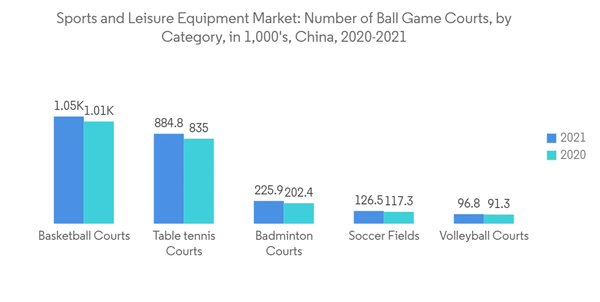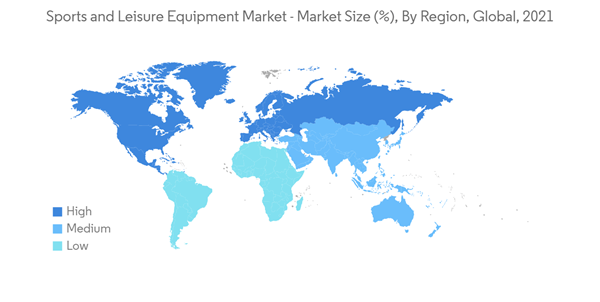Key Highlights
- The sports and leisure equipment market is projected to register a CAGR of 4.5% over the next five years.
- The booming enthusiasm for country-level and international tournaments is gaining tremendous followers worldwide. It is leading to a large number of athlete admissions every year, which is, therefore, propelling the demand for associated businesses, including sports and leisure equipment.
- The prominence of sports activities, especially ball sports, owing to health and wellness trends, the increasing influence of social media, and celebrity endorsement, encourage consumers to buy various sports equipment. For instance, according to Sport England, as of May 2021, approximately 61.5% of people in London participated in sporting activities with at least moderate intensity for more than 150 minutes a week.
- Additionally, several people are motivated to develop a home fitness routine coupled with an increasing preference for customized workout regimes (including workout timing) and a comfortable home-friendly environment, increasing the demand for sports and leisure equipment.
- Furthermore, owing to the increased working population worldwide, people increasingly participate in different sports activities to maintain their health and stay fit.
- For instance, according to NITI Aayog, over 522 million people were estimated to be employed across India in 2022, an increase from the previous financial year in which 516.6 million people were employed. By distribution channel although online retailing has remained a considerably stable distribution channel for the sales of sports equipment in the past, it is expected to gain more prominence in the future due to the associated convenience.
- However, specialty stores hold the largest share in the present market scenario. Moreover, increasing online retailing, widely spreading distribution channels, and easy availability of such required equipment and necessary courses are expected to boost the market's growth during the forecast period.
Sports and Leisure Equipment Market Trends
Increased Sports Participation Rate Owing to Favorable Government Initiatives
- Globally, there has been a significant rise in the percentage of the population adopting a healthy lifestyle, and the preference for staying fit has increased consumer indulgence in various sports activities. In line with the athleisure trend, consumers increasingly seek various sports and leisure equipment, especially ball sports.
- For instance, according to the State General Administration of Sports (China), as of December 2021, there were approximately 2.48 million ball game courts across China. Basketball courts ranked first in terms of numbers, amounting to more than a million, followed by table tennis courts and badminton courts.
- Moreover, increased government initiatives in various countries meant to improve sports participation have played a key role in driving the market over the last few years. For instance, in 2020, the Government of Australia announced its plan to invest USD 50.6 million in athletes over the next two years, i.e., 2021 and 2022.
- Similarly, according to NITI Aayog, the Government of India, in recent years, has taken several initiatives, such as Khelo India, TOPS Scheme, etc., to build India as a sporting nation with a great amount of emphasis in the rural areas. Such initiatives are expected to encourage more people to indulge in various outdoor sports, which, in turn, is expected to increase sports equipment sales.
Europe Holds Significant Share in the Market
- Europe holds a significant amount of market share, owing to the well-penetrated sports environment and enormous athlete participation rate witnessed in the region. Countries such as the United Kingdom are notable for the diversity of their sporting interest. Rugby union, golf, football, and tennis are among the most popular sports of the general population in the region.
- For instance, according to David Lange, in 2021, nearly 40.7% of male adults and roughly 31.7% of female people participated in sports every week in England. Apart from sports participation, the favorable weather condition (snowfall) attracts tourists from different parts of the world who indulge in winter sports. This creates a great opportunity for manufacturers involved in marketing equipment and sports garments, such as ski and snowboarding, which is expected to drive market growth in the region.
- To sustain in this competitive market, key players continuously introduce new sports and leisure equipment, take innovative initiatives, and try to differentiate in price, functionality, size, weight, and post-sales services. For instance, in July 2022, ASICS announced the launch of the GEL-KAYANO 29 running shoe. The company claimed that through ASICS' advanced technology, the latest GEL-KAYANO 29 is approximately 10g lighter1 than its predecessor. It claimed that the newly launched shoe also features a more energized feel due to the addition of FF BLAST PLUS cushioning in the upper midsole layer, providing a more energized ride at each step. Such innovative offerings by the manufacturers are expected to boost sales further, thus positively impacting the market's growth.
Sports and Leisure Equipment Industry Overview
The market studied is highly competitive and consists of regional and international competitors. Players like Adidas AG, Amer Sports, PUMA SE, and Under Armour dominate it. Other competitors in the market are Billabong International Colombia Sport, Daiwa Seiko, New Balance, and Quicksilver. These companies are focusing on digital and social media advertisements to make consumers aware of new product launches in the market. Key players are embarking on online distribution channels for their online marketing and branding of their products to expand their geographic reach and increase their customer base. Moreover, leading manufacturers in the market are focusing on leveraging opportunities posed by the emerging markets of Asia-Pacific, like Thailand and India, to expand their revenue base.Additional Benefits:
- The market estimate (ME) sheet in Excel format
- 3 months of analyst support
This product will be delivered within 2 business days.
Table of Contents
1 INTRODUCTION
4 MARKET DYNAMICS
5 MARKET SEGMENTATION
6 COMPETITIVE LANDSCAPE
Companies Mentioned (Partial List)
A selection of companies mentioned in this report includes, but is not limited to:
- Amer Sports
- Nike Inc.
- Adidas AG
- Puma SE
- Groupe Rossignol
- Under Armour
- Acushnet Holdings
- New Balance
- ASICSC Corporation
- Callaway Golf
Methodology

LOADING...










